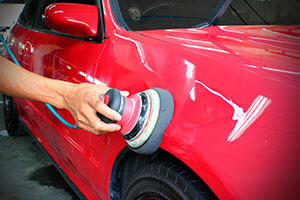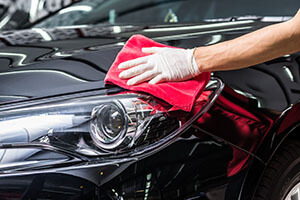The Makeup of a Scratch
 Before you can begin repairing any scratches in your car’s paint job, you must first diagnose the severity of your car’s scratches. Different scratches will require different maintenance. For instance, a simple, light scratch that is very shallow can be easily buffed out with a few household items. A deeper scratch, though, will likely require paint replacement or filling of some kind, and so it will need to be handled much more seriously.
Before you can begin repairing any scratches in your car’s paint job, you must first diagnose the severity of your car’s scratches. Different scratches will require different maintenance. For instance, a simple, light scratch that is very shallow can be easily buffed out with a few household items. A deeper scratch, though, will likely require paint replacement or filling of some kind, and so it will need to be handled much more seriously.
Get an Instant Online Offer for Your Car!
Enter your zip code below to get your FREE estimate and see how much your car is worth.
Get paid the real cash value of your car in 24-48 hours!
Cleaner Wax for Light Scratches
If a scratch is just on the very surface of your car’s paint job, it can likely be buffed out fairly easily with a microfiber cloth and some cleaner wax. Both are easy to find at your local autoparts store, hardware store or Walmart. If you can run your fingernail over the scratch and feel it, then you know the scratch is too deep for this method. However, if the cut is not deep enough to feel with your nail, then this method should be effective for ridding your paint job of some of the most dulling scratches.
To use cleaner wax to buff out scratches, pour a small amount of the stuff to an already-damp cloth. Wipe the cloth on the scratched surface are in small, clockwise circles. Continue this manual buffing technique until the scratches can no longer be seen. The cleaner wax acts as an extremely effective buffer, and essentially fills in the gaps that may be missing in the gloss layer of your car.
A More In-Depth Approach
It is likely that you will need to go to greater lengths to get rid of any substantial scratches you may encounter in the surface of your car’s paint job. Below are a few more detailed instructions for getting rid of scratches. You can begin with the first step and stop when you have successfully removed your car’s scratches to your own satisfaction.
Be careful. Whenever using a buffing compound on any type on a painted surface, you can quite easily create swirl marks or otherwise mar the paint, which is exactly the opposite of what you are trying to accomplish. If you are not comfortable fixing your own scratches, most car washes offer waxing services that may be a good alternative.
Step 1: Polishing Compound
A polishing compound can be used if you need just a hair more strength than cleaner wax. The compound will buff out all surface-level scratches. Before using a compound, it may be wise to tape of the section of the car in which you are removing scratches, as the compound will strip the top layer off of the surface of a car if it is left on the paint for too long or if it gets onto the plastic accents of a car. Use a small amount the compound and a polishing cloth on the affected areas. After ten or more circular motions over the scratch, use a dry cloth to buff away the left over compound. It is incredibly important that you remove the entire compound from the body of your car after removing the scratches.
Step 2: Swirl Mark Remover
After using a polishing compound, Swirl Mark Remover is a great option. This can be applied directly after the polishing compound. Simply use around a dime-sized amount of the product with a fresh cloth that is lint-free. Use the same circular motions, and this product will work to remove remaining scuffs that the compound may have missed.
Step 3: Solvent and Paint
If you have used the above tips and still have scratches to fill, it is likely that you will need to use paint, as the scratches are deeper than surface level. The first step to doing this includes using a solvent to remove any of the waxes or oils that may be on the surface of your car. Next, you will simply use primer paint to fill in the scratches. It is essential to find the correct match for the paint job already existing on your car. It is almost impossible to not run into some type of overlap, but you should avoid this as much as is feasible.
Step 4: Cure and Sand
Let the paint dry for around 24 hours, as the solvent needs to completely evaporate so that the lacquer can shrink. After the paint is dry, you can take sandpaper (600-1000 grit) and wet sand the freshly painted area carefully, to remove the paint that sits above the surface of the paint job. Make sure to do this step carefully, and to keep an eye on your progress as you go, as not to over-sand the paint. At this point, you will want to use compound again to keep the area that you are sanding more contained.
Step 5: Repeat as Necessary
It is probable that there will be uneven sections in your repair job, where the level of paint is not the same in different areas. To fix this, simply repeat the process by filling in spots that are low on paint as often as is necessary, until the surface is level. Each time, it is important to let the paint dry overnight, and wet-sand the paint down so that it does not protrude from the rest of the paint job.
Step 6: Finish Up
 After you have leveled out the paint and are content with the outcome, simply apply a clear coat to the surface you have repaired. Clear coats can be found in aerosol cans at an automotive store, and it is essential to use a gloss that is only intended for automotive spot repairs, rather than just any generic clear gloss paint. Then, reapply polish compound to the area you have been working on, using the same techniques as mentioned earlier. To ensure that the solvent is given plenty of time to escape from the paint and allow the lacquer to dry completely, avoid waxing the area for at least a month.
After you have leveled out the paint and are content with the outcome, simply apply a clear coat to the surface you have repaired. Clear coats can be found in aerosol cans at an automotive store, and it is essential to use a gloss that is only intended for automotive spot repairs, rather than just any generic clear gloss paint. Then, reapply polish compound to the area you have been working on, using the same techniques as mentioned earlier. To ensure that the solvent is given plenty of time to escape from the paint and allow the lacquer to dry completely, avoid waxing the area for at least a month.
Conclusion
There is no doubt that scratches on your car can be a nuisance, and a pain to have fixed. Body shops can charge outrageous amounts of money to repair the smallest of scratches, and that cost can build up quickly over time. The great news is that you can easily repair paint scratches by yourself, whether they are small and surface-level, or even deeper. Simply follow the provided steps, and you will be back on the road with a pristine paint job in no time. Or, have a professional do it.
If your car is beyond scratches and into the basketball-sized dents, you may just want to sell your car. Get a guaranteed, no-obligation offer from CarBrain, the smart way to sell your car.
